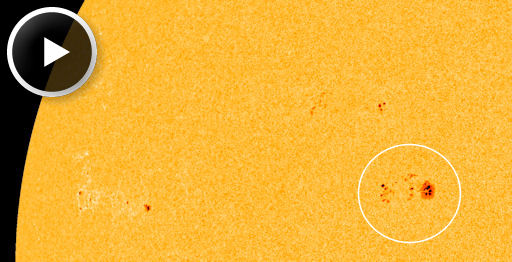MILD LEONIDS: The Leonid meteor shower peaks on Nov. 17/18 as Earth passes through a stream of debris from Comet Tempel-Tuttle. Reports so far are consistent with a weak shower--no more than about 10 per hour. In the past, Leonids have been known to produce fantastic storms of thousands of shooting stars. This year, however, Earth is passing through the outskirts of the comet's debris stream, so the shower is relatively mild. [meteor gallery] [meteor radar]
FAST-GROWING SUNSPOT: Barely visible when the weekend began, sunspot AR1619 has blossomed into a large active region more than three times as wide as Earth. Click to play a 24 hour movie recorded by NASA's Solar and Heliospheric Observatory:
So far the growing sunspot has not produced any significant flares, but the quiet is unlikely to continue if its expansion continues apace. Fast-changing magnetic fields on the sun have a tendency to reconnect and erupt. NOAA forecasters estimate a 20% chance of M-class solar flares during the next 24 hours.Solar flare alerts:

![]()
Solar wind
speed: 410.3 km/sec
density: 4.9 protons/cm3
explanation | more data
Updated: Today at 1426 UT
![]()
X-ray Solar Flares
6-hr max: M1 1241 UT Nov20
24-hr: M1 1241 UT Nov20
explanation | more data
Updated: Today at: 1400 UT
![]()
![]()
![]()
Daily Sun: 18 Nov 12
![]()
![]()
New sunspot AR1619 poses a threat for M-class solar flares. Credit: SDO/HMI
![]()
![]()
![]()
Sunspot number: 122
What is the sunspot number?
Updated 18 Nov 2012
Spotless Days
Current Stretch: 0 days
2012 total: 0 days (0%)
2011 total: 2 days (<1%)
2010 total: 51 days (14%)
2009 total: 260 days (71%)
Since 2004: 821 days
Typical Solar Min: 486 days
Update 18 Nov 2012
The Radio Sun
10.7 cm flux: 135 sfu
explanation | more data
Updated 18 Nov 2012
![]()
![]()
![]()
Current Auroral Oval:
![]()
Switch to: Europe, USA, New Zealand, Antarctica
Credit: NOAA/POES
![]()
![]()
![]()
Planetary K-index
Now: Kp= 2 quiet
24-hr max: Kp= 2 quiet
explanation | more data
![]()
Interplanetary Mag. Field
Btotal: 5.5 nT
Bz: 5.5 nT south
explanation | more data
Updated: Today at 1427 UT
![]()
![]()
![]()
Coronal Holes: 18 Nov 12
![]()
![]()
There are no large coronal holes on the Earthside of the sun. Credit: SDO/AIA.





